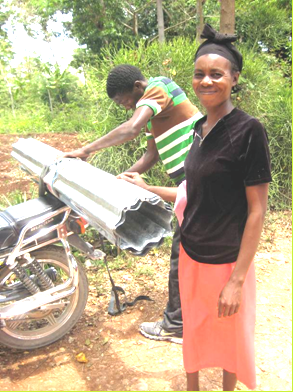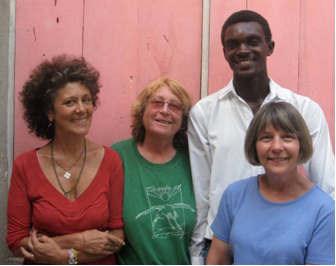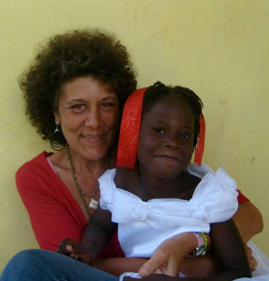
Cape Cod Volunteers Bring Education, Art and Healing to Haitian Community
by Ellen LeBow

Photograph by Ellen LeBow
Walking down the dusty road in Matènwa this April, we passed the guys who play dominoes every afternoon, rain or shine.
A new caution kept them from crowding onto the concrete porch where they traditionally played. Now they pounded their dominoes down on a rocky rise beneath a blue tarp between two skinny trees.
The wind was high. As we passed, it lifted the tarp, snapping it with the sound of a sharp gunshot. The players flew from their chairs, one crashing down the slope with a terrified shriek. In an instant, they were all laughing the embarrassed laugh of people whose trauma is still alive and well just below the surface of "life-goes-on."
As everyone knows, Haiti was changed forever on January 12 by an earthquake heard 'round the world. Images of apocalyptic devastation burned into our collective memories. Haitians now mark time by before and after the "Trembleman De Tè a" – Trembling of the Earth.
Our annual fundraiser on Cape Cod drew an epic crowd, generous beyond description, letting people in Matènwa rest assured they were not forgotten. On an immediate level, it has enabled us to send every member of the arts center enough cash to live on when food was dangerously scarce and expensive.
In Matènwa, it became our habit to ask people where they were when the earthquake hit.
We heard story after story of interweaving terror, wonder, grief and love.
One minute you're sitting on your porch shelling peas, they'd say. Or taking a bath, or coming home from school. The next, you can't stand up from the lurching. Your walls are splitting in front of your eyes; you don't know where your children are. Then the news comes from Port au Prince and you're sure everyone you know there is dead.

People showed us lean-tos where families slept outside. Wolan, Venez and their eight children, like so many others, made room for twenty-one friends and relatives fleeing the city, supporting them for weeks until supplies ran out. People camped out in the Art Center's courtyard and under its open-air stage.
 |
The money enabled everyone to feed and house this rush of refugees as well as their own families. The deep gratitude expressed for that unexpected gift overwhelmed us.
Kalin told, with poignant joy, how every night the neighbors came together to eat, sing, pray, share memories of the madness and the relief that they hadn't had to move to Port au Prince.
When we arrived in Matènwa, we knew our time was short and our goals long.
Lisa Brown came with two of her Nauset High School students. Their plan was to revive the music program she'd been cultivating in the local school.
As a Nauset biology teacher, Valerie Bell had prepared a lesson for teachers on how earthquakes happen.
Mike Andolina and I, two Wellfleet artists, came with a new printmaking technique, new project ideas and suitcases of long awaited art materials. The hope was to return home with a body of work to sell at RaRa, the Matènwa artists' new Wellfleet storefront.
Everyone was waiting for us, restless to begin working, to move on, to reconnect.
We helped the artists come up with images expressing their emotional reaction to the disaster. We talked with the art center's committee about new projects the artists and their neighbors wanted to fund.
A local entrepreneur named Jet got help to re-construct her little roadside restaurant with better building materials. A group of farmers secured funds to dig a water collecting cistern in their fields.

We sat in as the committee decided what criteria to use to disseminate to local gardeners a whole suitcase of vegetable seeds donated by students at the Worcester Polytechnic Institute. They made plans to fence in and prepare the art center's land for the artists' own food growing initiative.
The women's main concern this time was the condition of their houses. Almost everyone's home had suffered structural damage. Their biggest request was to help them reconstruct before another earthquake hit.
Fear of another disaster runs in people's blood.
Artists spoke of sleeping with doors unlocked for a quick getaway. There were rumors of floods that could sink the whole island and a new morbid curiosity about asteroids and volcanoes.
Little understanding of what an earthquake was fed a dread of the unknown and of a God that could do such a thing again. A few local evangelical pastors were using this lack of knowledge to foster the idea that people's own sinful ways were the cause.

One of the most powerful moments was watching Valerie Bell demonstrate how earthquakes happen in nature.
She had brought two things: a model of the earth split in half to reveal its thin top crust, vast molten core and magnetic stone heart, and a map showing the fault lines that snake over the whole world, cut into puzzle pieces.
With these she acted out how the mammoth plates continue to move beneath us, pressing up mountain ranges and making room for oceans.
As teachers and neighbors watched, they understood that a vengeful God did not single out Haiti. They saw earthquakes are part of the natural order happening all the time, and how the Caribbean happens to ride a long fault line.
They grasped that after movement comes relief of pressure, and life does go on.
We continue to come to the village of Matènwa in order to participate in life going on.
After the earthquake is the same as before the earthquake: like us, Haitians need secure jobs and continuing education if they are to thrive.
We work to relieve the artists' most ongoing concerns: "Will we continue? Can we count on our teachers to keep teaching and our work to support us, no matter what?"
To purchase the extraordinary silk, sequin, silkscreened and embroidered artwork of the Matènwa Artists visit their online store: www.artmatenwa.org/artworks.html
Or visit RaRa, their Cape Cod store at
6 Commercial Street, Wellfleet, MA
(508) 349-3433

Ellen LeBow is an artist and writer from Wellfleet. Co-founder of the Haiti Project, she works with the women artists of Matènwa to help them build livelihood and community through selling their hand-painted silk scarves and embroidered, sequined and beaded depictions of daily life in Haiti.
To see more of Ellen's Haiti images visit our Help Haiti Page.
You can see Ellen's artwork at the Rice/Polak Gallery, in Provincetown, where she will be the featured artist July 16th to July 29th. There will be an Opening Reception on Friday, July 16th, 7:00pm.